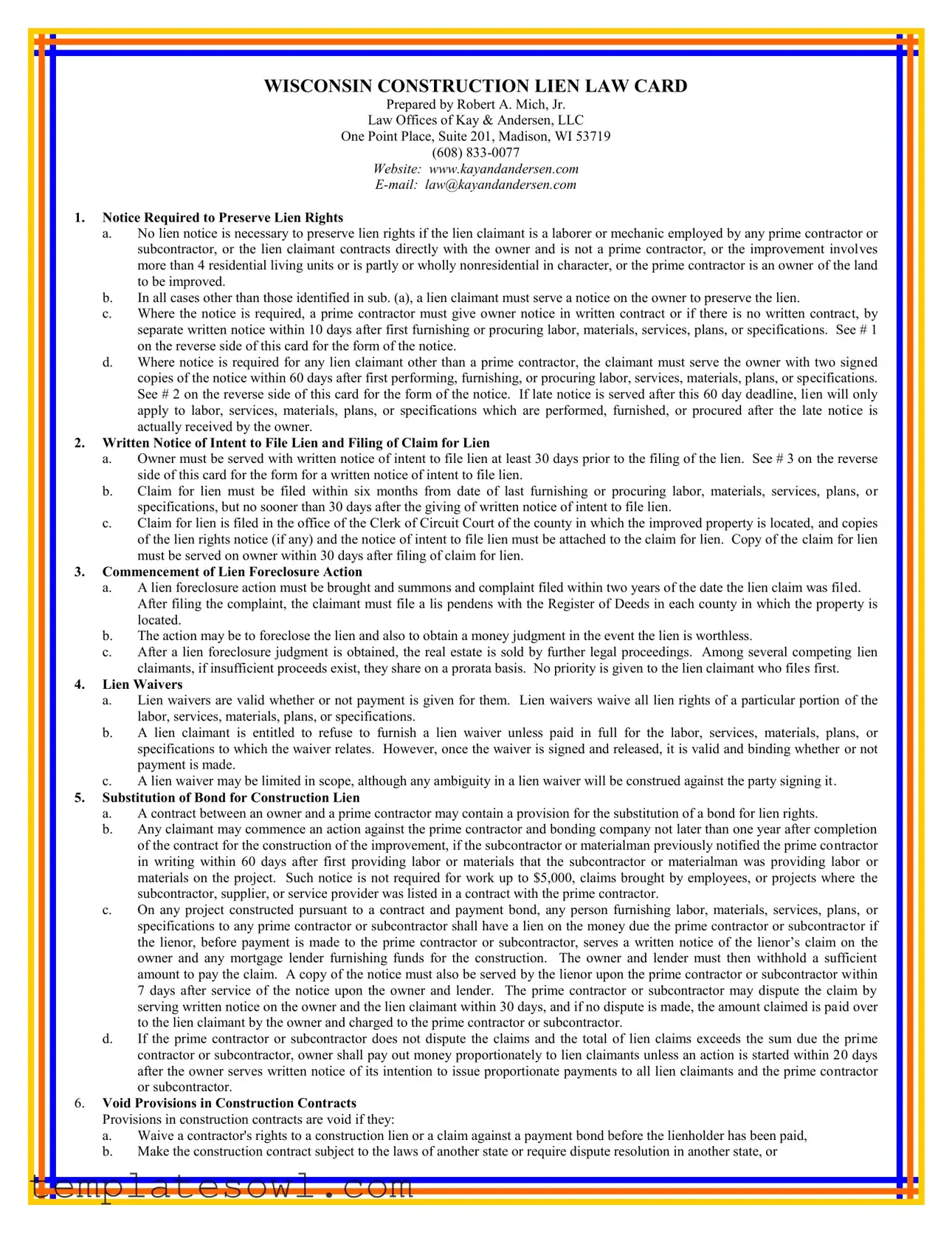c.Contain a provision making payment to a prime contractor a condition precedent to a prime contractor's payment to a subcontractor or supplier (pay-if-paid). However, a provision merely delaying a payment to a subcontractor until the prime contractor receives payment from the owner (pay-when-paid) is permitted.
7.Public Improvements (Lien Claims on Public Funds Due Prime Contractor)
a.Lien notice must be served on a clerk or treasurer of municipality or governmental agency responsible for the construction of the project, before payment is made to prime contractor. A copy of the notice must be served upon the prime contractor at the same time.
b.If prime contractor disputes the claim, action must be brought within three months from the time notice is served, otherwise the lien claim is barred.
c.If the prime contractor does not dispute claims and the total of lien claims exceed sum due prime contractor, governmental official shall pay out money on a proportional basis to lien claimants unless an action is started within 20 days after the official mailed notice to all claimants regarding the proposed distribution.
8.Suit on Bond in Public Improvements
a.A subcontractor, supplier, or service provider may sue prime contractor and sureties upon the bond for unpaid claims but action must be brought within one year after completion of work under the contract, provided the subcontractor, supplier, or service provider previously served the prime contractor with written notice of its work within 60 days after first performing, furnishing, or procuring labor, services, materials, plans, or specifications, unless one of the exceptions noted in paragraph 5.b. applies.
b.Some surety contracts require commencement of action before one year after completion of work. A copy of the surety bond should be obtained and complied with.
9.Federal Public Improvements (Miller Act, Title 40, Sections 3131 and 3133)
a.Performance and payment bonds are required on all United States contracts of more than $100,000.
b.Suit may be brought against surety after expiration of 90 days from the date of last furnishing labor or materials, but suit must be commenced within one year of the date that labor or material was last furnished.
c.A sub of a subcontractor or materialman of a subcontractor must give written notice to the prime contractor furnishing the payment bond within 90 days of last furnishing labor or materials in order to preserve action.
10.Service of Notices
All notices required under the Wisconsin construction lien law must be in writing and served by personal delivery, delivery by registered or certified mail, or another means of delivery in which the recipient makes written confirmation of the delivery. Service upon the state of Wisconsin must be performed by registered or certified mail.
* * * * * * * * * * * * * * * * * * * * * * * * * * * * * * * * * * *
1.Prime Contractor Notice -
A prime contractor’s notice of lien rights, whether included in a written contract or separately given within 10 days of first furnishing or
procuring labor, materials, services, plans or specifications, shall be in at least 8-point bold type if printed, or in capital letters if typewritten. It shall be given to the owner or the owner’s authorized agent in substantially the following language: “As required by the
Wisconsin construction lien law, claimant hereby notifies owner that persons or companies performing, furnishing, or procuring labor, services, materials, plans, or specifications for the construction on owner’s land may have lien rights on owner’s land and buildings if not paid. Those entitled to lien rights, in addition to the undersigned claimant, are those who contract directly with the owner or those who give the owner notice within 60 days after they first perform, furnish, or procure labor, services, materials, plans, or specifications for the construction. Accordingly, owner probably will receive notices from those who perform, furnish, or procure labor, services,
materials, plans, or specifications for the construction, and should give a copy of each notice received to the mortgage lender, if any.
Claimant agrees to cooperate with the owner and the owner’s lender, if any, to see that all potential lien claimants are duly paid.”
2.Subcontractor, Supplier or Service Provider Notice -
Every person other than a prime contractor shall have a lien only if within 60 days after performing, furnishing, or procuring the first labor, materials, services, plans, or specifications, the claimant gives written notice, in two signed copies, to the owner or the owner’s authorized agent. The notice shall be in substantially the following language, with the blanks filled in: “As a part of your construction contract, your prime contractor or claimant has already advised you that those who perform, furnish, or procure labor, services, materials, plans, or specifications for the work will be notifying you. The undersigned first performed, furnished, or procured labor, services, materials, plans, or specifications on . . . (give date) for the improvement now under construction on your real estate at . . . (give
legal description, street address, or other clear description). Please give your mortgage lender the extra copy of this notice within 10 days after you receive this, so your lender, too, will know that the undersigned is included in the job.”
3.Notice of Intent to File Lien -
No lien claim may be filed or action brought unless, at least 30 days before timely filing of the lien claim, the lien claimant serves on the owner a written notice of intent to file lien claim, in substantially the following language: "You are hereby notified that the undersigned lien claimant intends to file a lien claim under the Wisconsin Construction Lien Law for labor, materials, services, plans, or specifications furnished in connection with the work of improvement done or being done on your real estate at (give legal description, street address or other clear description), said improvement being (describe briefly) and being done pursuant to a contract between (identify prime contractor and owner). Said lien claim of the undersigned is in the amount of $___________. The undersigned last furnished labor, materials, services, plans, or specifications for said improvement on your land on (date) and intends to file a construction lien claim pursuant to § 779.06 of the Wisconsin Statutes, on a date no later than six months after said date of last furnishing labor, materials, services, plans, or specifications, and no earlier than 30 days after you receive this notice, unless you pay and satisfy said lien claim prior thereto."
The user of this card is encouraged to consult with his or her own attorney regarding its contents. See Chapter 779, Wisconsin Statutes and related case law for detailed requirements for preservation and enforcement of lien and bond claims in Wisconsin.


